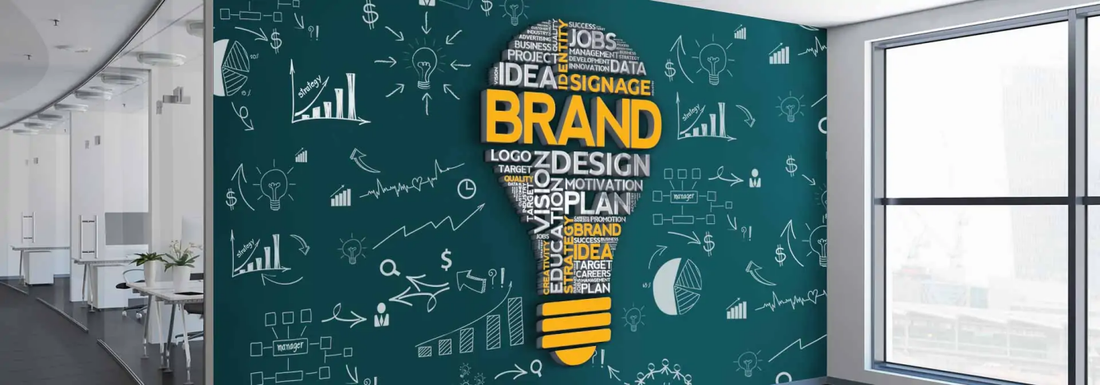This sponsor article is contributed by @Sarah Watson
A company's logo is more than just a symbol; it's the face of the business. When visitors walk into a company lobby, the logo is often one of the first things they notice. This logo can leave a lasting impression and help tell the story of the brand.
Effective branding in the lobby sets the tone for what the company is all about and can make visitors feel welcome and impressed. It shows that the business is professional and serious about its image.
A well-designed logo in the lobby can also boost employees' morale and sense of pride in where they work.
What is a Company Logo?
A company logo is a unique design that represents a business's identity. It includes symbols, text, or a combination of both, and it makes the company easily recognizable. The primary purpose of a logo is to create a memorable image in consumers' minds so they can instantly associate it with the company it stands for.
The history of logos is quite interesting. Logos have been used for centuries, even dating back to ancient civilizations. For instance, ancient Egyptians used symbols to represent their gods and pharaohs. In medieval times, businesses like blacksmiths and taverns used signs to show what services they offered. As time passed and printing technology improved, logos became more common in advertisements and on products.
With the rise of large corporations and global brands in the 20th century, logos became essential for businesses. Companies like Coca-Cola and Apple developed simple yet powerful logos to set themselves apart from their competitors. Today, logos continue to evolve with trends in design, technology, and consumer preferences, but their core purpose remains the same—to represent the brand and what it stands for.
The Psychological Impact of Logos on Visitors
First impressions are incredibly important, especially in a business setting. When visitors walk into a company lobby, the logo is more than just decoration; it is a significant visual cue. A clear and attractive logo can tell visitors a lot about the company’s character and values right away. It demonstrates professionalism and commitment to quality.
For instance, if a logo is sleek and modern, visitors might assume that the company is innovative and forward-thinking. On the other hand, a traditional and classic logo might suggest reliability and a long-standing reputation.
The way a logo is displayed in the lobby can also affect visitors' feelings. A well-lit, prominently placed logo can create a sense of importance and trust. It says, “We are proud of who we are and what we do.” This positivity can make visitors feel more welcome and confident about doing business with the company.
Visual cues like color, shape, and design elements in a logo can trigger specific emotions and associations. For example, blue often conveys trust and calmness, while red can signify energy and excitement.
Similarly, using an automatic writing machine or an automatic handwriting machine in the office can enhance the professional image. A handwriting machine with feeder or an automatic signature machine can ensure consistency and reliability, reflecting the company’s commitment to quality.
Even a handwriting machine for letters can add a personal touch that promotes trust and engagement with clients.
Key Elements of Effective Branding
Effective branding in a company lobby involves several important elements that come together to create a strong impression. One crucial aspect is consistency. The colors, typography, and style of the logo should match other branded materials like business cards, websites, and advertisements. This coherence helps create a unified brand image that visitors can easily recognize.
- Lighting is another key element. Proper lighting can highlight the logo and make it stand out. A well-lit logo can draw attention and make the space feel more welcoming and professional. Consider using spotlights or backlighting to emphasize the logo effectively.
- Placement is also vital. The logo should be positioned where it can be easily seen when people enter the lobby. Common choices include above the reception desk or on a feature wall. Proper placement ensures that the logo is one of the first things visitors notice, creating a strong first impression.
- Material choice can also make a significant difference. High-quality materials like metal, glass, or wood can add a sense of durability and sophistication to the logo. Working with experts in sign fabricationcan ensure the logo looks its best and lasts a long time.
To see these elements in action, consider some case studies of successful lobby branding. For example, Google's lobby branding features bright colors and bold shapes that reflect its fun and innovative culture. In contrast, a company like IBM uses sleek, modern fonts and a minimalist design to communicate professionalism and reliability.
Design Principles for a Memorable Logo
When designing a logo, two key elements to consider are color psychology and typography. Colors in a logo can influence how people feel when they see it. Different colors can evoke different emotions. For example, blue is often seen as trustworthy and calming. Brands like Facebook and Twitter use blue to make users feel at ease. Red, on the other hand, can create a sense of urgency or excitement. Think about brands like Target or Coca-Cola that use red to grab attention and stand out.
Typography, which is the style and appearance of the text, is just as important. The font you choose for your logo can say a lot about your brand. A modern, sleek font can make your company look cutting-edge and innovative. Companies like Tesla use modern fonts to show that they are forward-thinking. Traditional fonts, like those with serifs, can make a business appear established and reliable. For instance, newspapers like The New York Times use serif fonts to convey a sense of reliability and history.
When using tools like pen plotters and xy plotters to create logos, precision is key. These large-format drawing robots and calligraphy plotters can help you design intricate and detailed logos that stand out. Similarly, drawing robots and handwritten robots can add a personal touch, making your logo unique. These tools are especially useful for businesses that want to incorporate detailed typography or custom calligraphy into their branding.
Measuring the Success of Your Branding Efforts
A key part of making sure your branding is effective is measuring its success. There are several ways to see if your branding efforts are working. One important method is to get feedback from your customers.
You can do this through surveys, interviews, or even by looking at comments on social media. Pay attention to what people are saying about your logo and brand. Are they positive? Do they understand what your company is about? This direct feedback gives you valuable insights.
Another way to measure success is by looking at your company's performance metrics. Check if there is an increase in website traffic and social media engagement after you launch a new branding campaign. Higher numbers can mean that more people are noticing and interacting with your brand. You can also track sales figures to see if more customers are buying your products or services.
Lastly, keep an eye on your competitors. See how your logo and branding compare to theirs. Are you standing out? If people recognize your brand more than others, that's a good sign that your branding is effective. By using these methods, you can get a clear picture of how successful your branding efforts are and where you might need to make improvements.





